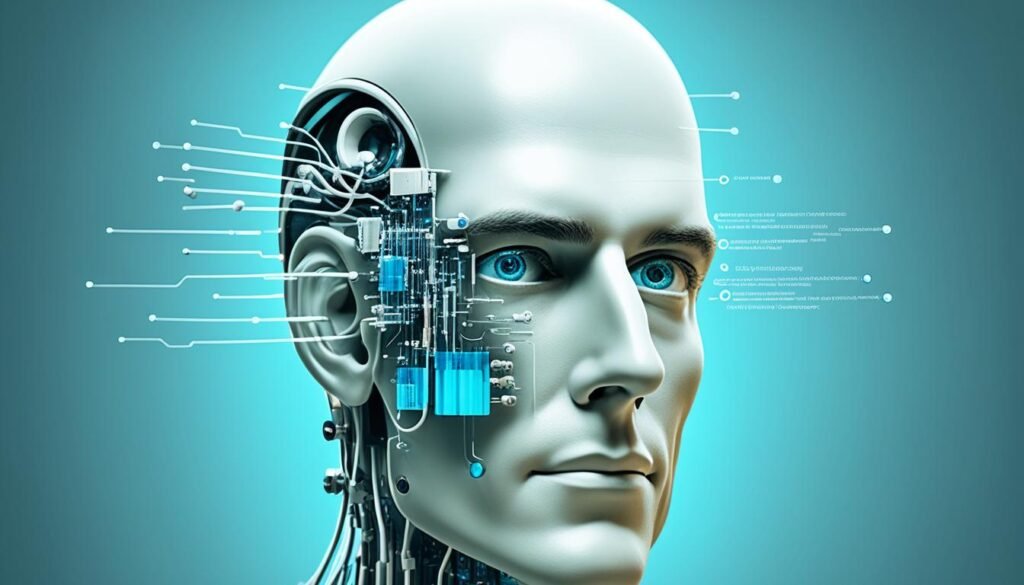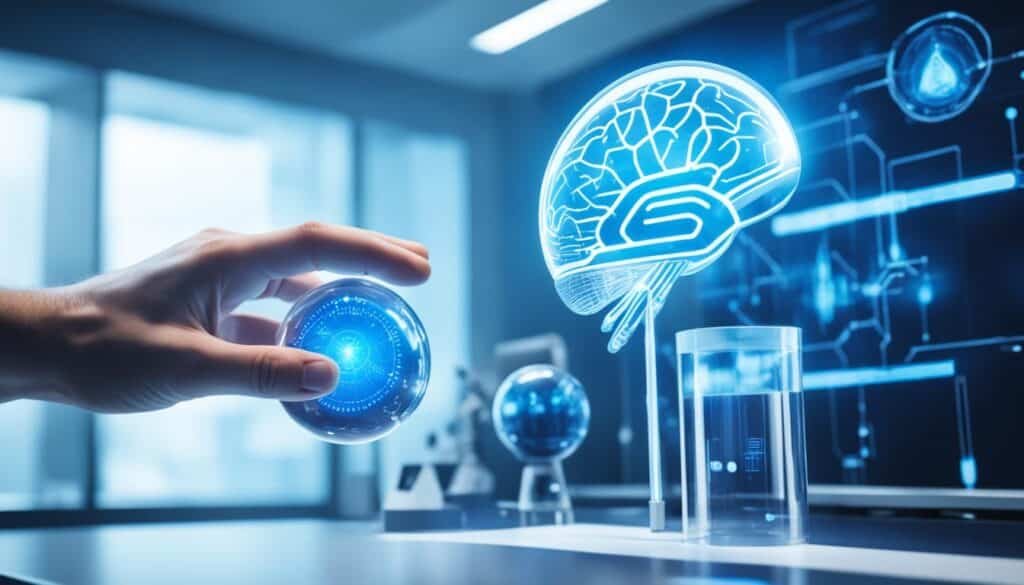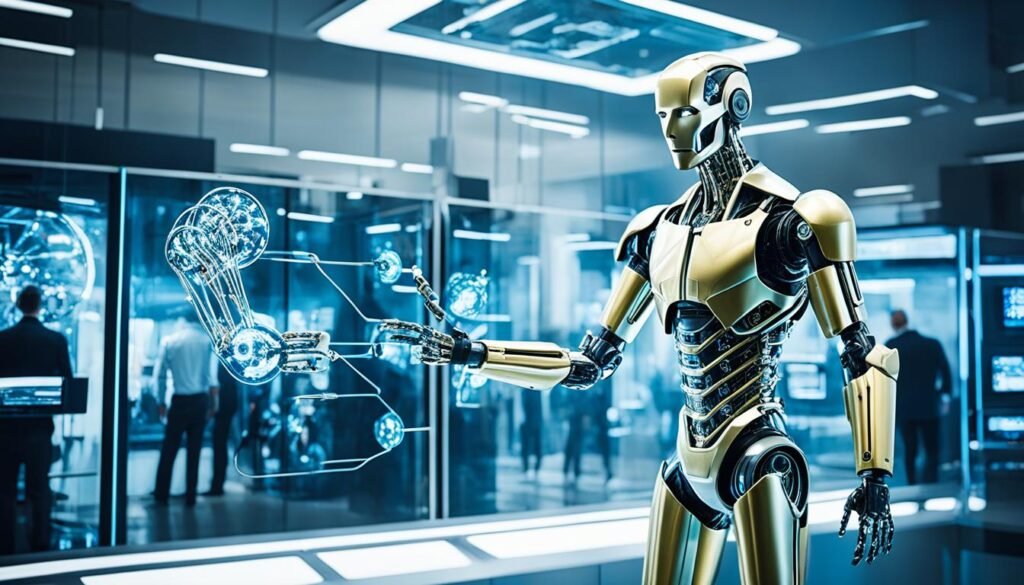In the last hundred years, people have lived about twenty years longer on average1. This jump in life expectancy is just the start of what transhumanism dreams for humanity’s future. Transhumanism is a movement that wants to change humans a lot using new tech and reason. It aims to boost our thinking, body, and mind2. But, making these changes is still a big question in science and ethics.
Genetic engineering and CRISPR technology are now making it possible to prevent genetic diseases1. They also help us improve our natural traits or add new ones2. CRISPR lets us edit genes precisely1. New tech like nanotechnology, biotechnology, info tech, cognitive sciences, and AI are all shaping the future of transhumanism2.
But, as tech gets better, so do the ethical issues with human enhancement. Using cognitive enhancement tools like nootropics, brain-computer interfaces, and neural implants makes us wonder about fairness and who gets to use them1. Also, trying to live longer with AI and nanotechnology makes us think deeply about what it means to be human and what life is all about.
We’re getting close to a technological singularity, where humans and machines might merge by 20452. It’s important we talk openly about the right and wrong of transhumanism. By thinking carefully about the good and bad sides, we can try to make a future that’s good for everyone.
Key Takeaways
- Transhumanism aims to greatly improve human abilities with new tech and reason.
- Genetic engineering and CRISPR are opening doors to prevent diseases and boost traits.
- Techniques like nootropics and brain-computer interfaces bring up tough questions on fairness and access.
- Trying to live longer with AI and nanotechnology makes us ponder the essence of being human.
- As we near a technological singularity, it’s key to have honest talks about transhumanism’s ethics.
Introduction to Transhumanism
Transhumanism is a movement that looks to the future. It aims to improve humanity by using advanced technology. The idea was first shared by Julian Huxley, an English biologist and philosopher, in 19573. Since then, it has grown, especially in the U.S., becoming a key scientific project with global influence4.
Defining Transhumanism
Humanity+, formerly the World Transhumanist Association, defines transhumanism. It’s about using technology to stop aging and boost our mental, physical, and emotional abilities. This idea is central to the movement. It aims to use reason and new tech to better our lives and create a “posthuman” future.
“Transhumanism is a class of philosophies of life that seek the continuation and acceleration of the evolution of intelligent life beyond its currently human form and human limitations by means of science and technology, guided by life-promoting principles and values.” – Max More, philosopher and futurist
Key Ideas and Goals of Transhumanism
The main goals of transhumanism are:
- To boost our mental, physical, and emotional abilities with advanced tech
- To move towards an enhanced “Human 2.0” and then “posthumans” with abilities far beyond ours
- To extend life and aim for immortality through technology
- To use new tech responsibly for humanity’s betterment
Transhumanists believe in guiding the growth of transformative tech to shape our future. They think this can help humanity reach its full potential. Many big names in tech, like Google, PayPal, and SpaceX, support this vision4.
The growth of transhumanism brings up big questions about our future and the ethics of changing who we are with tech. These questions will keep the debate alive about transhumanism’s impact on us and our world.
The Human Condition and Enhancement

The human condition covers many aspects of life, like birth, childhood, and aging. It also includes love, sex, and death. Transhumanism is a movement that uses new technologies to make humans better. It aims to improve our lives beyond what we can do now5.
Understanding the Human Condition
Understanding human enhancement means looking at our complex lives. From the start, we grow, learn, and find ourselves. In childhood and adolescence, we shape our identities and connect with others.
Love and sex become key parts of our lives, leading to new life. But, aging brings changes that can affect our lives. Death is a reality that makes us seek ways to live longer and better. This is where transhumanism comes in as a possible solution.
Defining Enhancement in the Context of Transhumanism
Transhumanism wants to use new tech to make us better in many ways. This includes making our bodies and minds stronger, smarter, and more emotional6. Enhancement means using tech to boost our traits and make life easier and happier6.
Improving our thinking and moral behavior is key in transhumanism6. This helps us think better, make decisions, and live in today’s complex world. It also helps us be kinder to each other, creating a better society.
Transhumanism sees enhancing humans as a thoughtful choice6. It values our right to decide how to improve our lives. But, we must think about fairness, who can get these improvements, and the risks they bring.
The enhancements from these technologies could change human history more than anything else5.
As we look into enhancing humans, we need to talk openly about the right and wrong of it. We should think about the good and bad sides of transhumanist tech. This way, we can aim for a future that makes life better for everyone, respecting everyone’s dignity.
Controversy and Debate Surrounding Transhumanism
Transhumanism is a big topic in bioethics. It talks about using biotechnology to make new humans better than us. These new humans could live longer and think better7. Some people like the idea of making babies with certain traits or replacing limbs with better ones7.
But, this idea makes many people worried. They think making humans better could make some people richer and leave others behind7. Some worry that only the rich will get these new technologies8. Others think it could make society more divided8.
Transhumanists say they want to make enhancements available to everyone. They think it will get cheaper over time, like how mobile phones did8. But, they also think it might take a lot of money, which could be used for other things7.
People from many fields are talking about this topic7. They are discussing what it means to be human and what makes life good7. Some think we should think more about the moral sides of these new technologies7.
As technologies advance, society must consider how much enhancement is tolerable and define the ideal outcome for human flourishing.
Experts say we need to talk more about the risks of new technologies8. For example, athletes with special prosthetics might be too good at sports, which could cause problems8.
| Controversial Enhancement | Ethical Concerns |
|---|---|
| Designer Babies | Selecting offspring traits, potential for increased inequality |
| Advanced Prosthetics | Replacing healthy limbs with superior prosthetics, fairness in sports |
| Superintelligent AI | Risks associated with creating artificial intelligence surpassing human capabilities |
We need to keep talking about these new technologies7. It’s important to think carefully about how they will change us and our world7.
Historical Timeline of Transhumanism

Transhumanism aims to use technology to boost human abilities. It has roots in ancient times9. The Sumerians wanted to improve human capabilities9. Throughout history, people have sought immortality, from myths to alchemy9.
Julian Huxley, a British biologist, coined “transhumanism” in 195710. He saw it as a way to overcome human limits with science and technology. Huxley’s 1951 essay “Knowledge, Morality and Destiny” introduced the term11.
Early Roots and Influences
Transhumanist ideas come from many thinkers. In 1486, Giovanni Pico della Mirandola wrote “Oration on the Dignity of Man,” a key text11. The Enlightenment focused on science and improving life through it9. This led to ideas about enhancing humans through science in the 18th and 19th centuries9.
Francis Bacon and Henry Francis Cary also shaped transhumanist thought. Bacon advocated for scientific methods in 162011. Cary used “transhuman” in a translation of Dante’s work in 181411. Francis Galton introduced “eugenics” in 188311. J. B. S. Haldane’s 1923 essay was a big influence on transhumanism11.
Modern Development and Spread of Transhumanist Ideas
In the 20th century, transhumanism became more popular. FM-2030 and Max More helped spread the ideas. Max More introduced the modern concept of transhumanism in 199510. He and Natasha Vita-More started the Extropy Institute in 1988.
James Hughes and Zoltan Istvan are also key figures. Hughes supports democratic transhumanism, while Istvan advocates for libertarian transhumanism10. Humanity+, formed in 1998, aims to unite transhumanists and promote ethical technology use.
The technological singularity, discussed by Ray Kurzweil in 2005, is a key topic. It’s the idea that technology will soon surpass human intelligence10. Groups like Singularity University explore how this could change our future.
Genetic Engineering and CRISPR Technology
Genetic engineering has seen big leaps forward, especially with CRISPR technology. CRISPR stands for Clustered Regularly Interspaced Short Palindromic Repeats. It’s a tool that lets scientists change DNA with precision. This has opened doors in disease prevention, treatment, and even making humans better.
In the last 20 years, the Transhumanism movement has grown. It aims to improve humans through tech, like genetic engineering and info tech12. Transhumanists want to extend health spans, wipe out diseases, and boost our mental and physical abilities12. Gene therapy is about fixing genetic flaws to prevent or cure diseases, which could greatly improve health care13.
Potential Applications in Disease Prevention and Treatment
CRISPR is showing great promise in medicine. Scientists are looking into it for treating genetic diseases like sickle cell anemia and Huntington’s disease. By editing genes, they aim to create therapies that could cure or ease symptoms.
Genetic engineering is also big in farming, making crops and animals that resist pests and diseases. This helps farmers grow more food safely13. It’s also used in making medicines, like insulin and growth hormones, showing its wide potential13.
Ethical Concerns and Implications of Genetic Modification
CRISPR and genetic engineering bring up big ethical questions. One big worry is making “designer babies” with certain traits. Supporters see it as a way to boost traits like smarts or looks, fitting with what people want13. But critics fear it could lead to harmful eugenics and worsen social gaps.
Supporters of genetic enhancements believe in the right to choose traits for their kids13. But, opinions within the transhumanism movement vary, sparking debates on ethics and risks. These debates cover safety, fairness, and the ethics of some methods13.
| Argument | Proponents | Critics |
|---|---|---|
| Designer babies | Enhancing desired traits, reproductive freedom | Eugenics, exacerbating inequalities |
| Safety concerns | Rigorous testing and regulation | Unpredictable effects, long-term risks |
| Accessibility | Potential to become widely available | Widening gap between rich and poor |
As genetic engineering gets better, we need to talk more about its ethics and risks. Finding a balance between health gains and social fairness will be tough. But, with careful development and rules, CRISPR and genetic engineering could change healthcare and better our lives.
Physical Enhancement through Transhumanism

Transhumanism is a movement that started in the late 1980s. It uses technology to make humans better and get past our limits14. It looks at ways to make our senses and bodies stronger, offering big benefits like better senses, more strength, and better health1415.
Enhancing Sensory Perception and Physical Abilities
Neil Harbisson is a great example of how technology can change our senses. He was born colorblind but got an antenna in his skull. This lets him hear colors as sounds, giving him a new way to see the world.
Transhumanist tech also aims to boost our physical abilities. Scientists are working on advanced prosthetics and exoskeletons for people with paralysis or amputations. These devices could make people stronger than average humans14.
Overcoming Disabilities and Limitations
Transhumanism wants to go beyond just making us better. It aims to get rid of disabilities and push what we see as normal. By using new tech like genetic engineering and brain-computer interfaces, they hope to cure diseases, stop aging, and break through our biological limits14.
But, making us better with technology brings up big ethical questions. Some say it could make things worse for those who can’t afford it14. Others worry about changing who we are too much, losing our sense of self, and changing our values16.
| Potential Benefits | Ethical Concerns |
|---|---|
| Enhanced sensory perception | Exacerbation of social inequalities |
| Increased physical abilities | Identity transformation |
| Elimination of disabilities | Moral status shifts |
| Reversal of aging | Loss of meaning for unenhanced individuals |
As transhumanist tech gets better, we’re facing tough choices. We need to think hard about the right way to use these technologies. We should make sure they help everyone, not just some, and don’t lead to more unfairness or discrimination.
Artificial Intelligence and Transhumanism
Artificial intelligence and transhumanism are now more connected than ever. AI’s growth offers new ways to improve our minds and change us deeply. Transhumanists believe in using science and tech to make us better and guide our evolution17. They see AI as key to boosting our smarts and solving tough problems we can’t handle now.
AI as a Tool for Cognitive Enhancement
AI is being looked at for making us smarter through brain-computer interfaces and neural implants. Companies like Neuralink, led by Elon Musk, aim to link humans and AI closely. This could let us merge with machines and keep up with AI’s growth17. Such tech could boost our brain power, memory, and speed, giving us huge cognitive boosts.
AI is also making us smarter in many areas with tools like Siri and Alexa, and in fields like medicine and finance. It gives us access to tons of info and helps us make better choices. As AI gets better, it could be a key tool for making our minds even more powerful.
Concerns and Risks Associated with Advanced AI
AI’s potential to make us smarter is big, but so are the risks. A big worry is creating a superintelligent AI that’s too smart for us to control18. Such a system might have goals that don’t match our values, leading to big problems for us all.
AI could also make things worse for some people, making a gap between those who have AI help and those who don’t17. It could also cause social and environmental issues by spreading false info and complex lies17.
It’s important to balance AI’s good and bad sides in transhumanism. Zoltan Istvan, a big name in transhumanism, says AI could be as big a deal as Christmas in 15 years18. We need to make sure AI helps everyone and fits with our values as we move forward with AI and transhumanism.
Religious Perspectives on Transhumanism

In the late 1980s, the transhumanist movement started among tech folks in San Francisco19. It sparked debates in religious circles. The book “Religious Transhumanism and Its Critics” from 2019 mixes transhumanist ideas with religious views20. This movement wants to live forever through tech, bringing up tough questions about religion, ethics, and improving humans.
Some religious leaders see transhumanist tech as “playing God” and disrespecting human dignity. Others believe using our brains to better ourselves is right and shows our creative side. The Christian Transhumanist Association (CTA), started in 201420, tries to link Christian beliefs with transhumanism. But, the two views clash because transhumanism focuses on the material world, while Christianity looks to the spiritual.
Transhumanists often clash with monotheistic faiths, seeing them as obstacles to human progress19. Most transhumanists are atheists, preferring science over religious beliefs19. Big names like Elon Musk and Peter Thiel support transhumanism and have a big say in Silicon Valley19. The World Transhumanist Association (WTA), started in 199821, and groups like Singularity University and the Future of Humanity Institute19 push transhumanist ideas.
It’s important to hear from religious groups as we figure out the right way to use transhumanist tech. A team, led by George F. McLean, talked about how science and tech change us21. They looked at three big topics: what makes us human, if we should aim for transhumanism, and finding a spiritual side to life21.
“The ideas of transhumanism and Christianity are very different, as transhumanism wants to change us physically while Christianity focuses on our spiritual growth.” – Wesley J. Smith, host of the Humanize podcast and chairman of the Discovery Institute’s Center on Human Exceptionalism20
As more young people in the West don’t believe in religion, the talk about transhumanism and faith gets more important20. With tech and medicine always getting better21, and predictions that tech will be in us by 204519, we need to think deeply about the big changes we’re making. We should look at these changes from different religious views.
Socioeconomic Implications of Human Enhancement
Human enhancement technologies blend nanotechnology, biotechnology, and more to change society and how we interact22. These advancements could greatly improve our lives and abilities. But, they also bring up big worries about fairness, bias, and how society will change23.
Potential for Increased Inequality and Discrimination
Human enhancement could make things worse for those already left behind. If only the rich can get these technologies, we might see a society where some have big advantages over others23. This could lead to new kinds of bias, making things harder for those who can’t afford or don’t want enhancements.
The idea of “technomoral wisdom” is key to handling the ethical sides of human enhancement. It’s about making sure we don’t sacrifice the good of society for personal gains24. We need to think ahead to stop a “superior class” from getting too many benefits.
Long-term Impact on Society and Human Interactions
More people using enhancement tech could change how we connect with each other. With more cognitive and physical boosts, we might question what makes us human23. It could make us rethink our sense of self and how we fit into groups.
Also, living longer thanks to new tech could put a big strain on our society23. A population living longer could overwhelm healthcare and social services, making things harder for everyone. Finding a balance between living longer and sharing resources will be key.
| Socioeconomic Implication | Potential Consequences |
|---|---|
| Unequal access to enhancement technologies | Increased inequality and discrimination based on enhanced abilities |
| Altered human interactions and relationships | Redefining identity, authenticity, and social dynamics |
| Pursuit of radical life extension | Strain on healthcare systems, social services, and resources |
We need to talk about these risks and plan carefully to make sure everyone has fair access to enhancements. By thinking ahead and making responsible choices, we can enjoy the good parts of human enhancement without the bad.
Philosophical Arguments For and Against Transhumanism

Transhumanism is a set of ideas that aim to overcome traditional human limits like death and disease25. It supports using technologies like genetic engineering and artificial intelligence to make humans better2526. These technologies could lessen suffering and increase happiness, making humans more capable.
But, there are strong arguments against it. Critics worry about losing what makes us human and the ethics of changing us. Francis Fukuyama sees transhumanism as dangerous, saying it could erase our shared human nature25. He believes in keeping our basic human qualities to ensure equality.
There are different views on this topic. Nick Bostrom disagrees with Fukuyama, saying our biology shows we’re not fixed. He thinks we should be able to choose how to improve ourselves25. He points out that things like pacemakers and organ transplants already help us live longer.
At the heart of the debate are big questions about ethics. Transhumanists believe making humans better can help everyone. But, there are worries about fairness and the risks of these changes.
The debate on transhumanism is complex and deep. With new technologies like CRISPR and AI coming up, we must think carefully about their impact2627. We need to talk and think deeply to make sure these changes are good for everyone.
Cognitive Enhancement through Technological Means

Transhumanism aims to boost our mental abilities and physical strength, among other goals28. It focuses on making our brains work better through tech. This includes nootropics, smart drugs, brain-computer interfaces, and neural implants. These technologies are changing how we think and learn.
Nootropics and Smart Drugs
Nootropics, or smart drugs, help improve our thinking skills like memory and creativity. Here are some examples:
- Adderall – a stimulant for ADHD, sometimes used for more cognitive boost
- Modafinil – helps keep you awake and sharp
- Piracetam – might make memory and learning better
- Caffeine – a stimulant that keeps you alert and focused
These substances can make us think better for a while, but their long-term effects are still being debated. There are worries about side effects, addiction, and risks. This has led to discussions on the ethics of using nootropics for brain boosts28.
Brain-Computer Interfaces and Neural Implants
Brain-computer interfaces (BCIs) and neural implants directly enhance brain functions. They connect our brains to devices to improve or restore abilities. They’re mainly used to help people with disabilities, like:
- Cochlear implants for hearing
- Retinal implants for seeing better
- Motor neuroprosthetics for paralysis
But, these technologies could do more in the future. They might let us talk directly to computers, improve memory, and access information easily29. Research and tech progress could even lead to replacing organs with better tech versions, making us live longer and healthier29.
| Technology | Current Applications | Future Possibilities |
|---|---|---|
| Nootropics and Smart Drugs | Short-term brain boosts, ADHD and narcolepsy treatment | Less side effects, targeted brain enhancements |
| Brain-Computer Interfaces | Helping people with disabilities, restoring functions | Talking to computers directly, better memory, easy info access |
| Neural Implants | Cochlear and retinal implants, motor neuroprosthetics | Brain boosts, sensory upgrades, neurological disorder treatments |
As these technologies get better, we need to think about their ethics and who gets to use them28. Making sure they’re fair, stopping misuse, and avoiding bad effects will shape their future3029.
Transhumanism and the Pursuit of Immortality

The dream of living forever has been with us for thousands of years. Transhumanism offers a new way to think about this dream. By using the latest technology, transhumanists believe we can live longer and maybe even never die. This section looks at how we might live longer and the big questions that come with it.
Life Extension Technologies and Research
Scientists are now working hard to understand aging and how to slow it down. They’re looking at genetics, cells, and metabolism to find ways to make us live longer. Transhumanists think that things like genetic engineering and nanotechnology can help us live longer and better31. Nanotechnology is a big part of this, working at a tiny scale to change medicine and improve us through things like targeted treatments and tiny robots32.
There are also ideas like uploading our minds to computers, which could mean living forever in a digital world32. But, it’s a tough challenge because our brains are very complex. Another idea is cryonic freezing, where people freeze their bodies to be brought back later. About 500 people are already frozen in this way32.
Ethical and Existential Considerations of Radical Life Extension
Living a long time or never dying brings up big questions. Some say that death gives life meaning and makes us act with urgency. They worry that living too long could be boring or make us lose our drive. They also think it could cause big disagreements about who is truly human31.
But, transhumanists see the good side. They think living longer lets us do more, experience more, and help others more. They think we should change our societies to fit longer lives instead of accepting death as the end31. Still, they know that living forever raises big questions about how to share resources and how to keep life extension technologies going.
While the idea of living forever is tempting, we need to think deeply about the big questions it brings up. We must keep talking as we move forward with these new technologies.
Regulating and Governing Transhumanist Technologies

As transhumanist technologies grow, we need strong rules to make sure they’re safe and used right. Some see transhumanism as a way to make people better, but others call it dangerous33. We must work together worldwide to handle these new technologies wisely.
It’s hard to set rules for transhumanist tech because it means different things to different people33. Some want to use tech to make people smarter, look better, and live longer33. But this could lead to new kinds of beings that are very different from us33.
Others think of transhumanism as a choice, like picking what makes you better33. They believe it’s about making life better for each person33. Yet, this idea could create unfairness if not everyone can get these upgrades33.
Wearable tech and implants make things even more complicated. Since the 2000s, lawyers have been thinking about how to handle these devices34. It’s tricky to decide who or what the law applies to in these cases34.
| Regulatory Concern | Key Considerations |
|---|---|
| Safety and Efficacy | Ensuring transhumanist technologies are thoroughly tested and meet rigorous standards before widespread use |
| Equitable Access | Developing policies to prevent the widening of socioeconomic gaps due to unequal access to enhancement technologies |
| Privacy and Data Security | Safeguarding personal data collected by wearable devices and implants, and protecting against unauthorized access or misuse |
| Ethical Guidelines | Establishing a global framework for addressing the ethical implications of human enhancement and setting boundaries for acceptable practices |
We need to find a balance between personal freedom and the good of all. This means listening to different cultures and agreeing on what’s right globally. Working together and making smart policies will help us enjoy the good parts of these new technologies safely.
The need for a properly constituted State to protect individuals from unwanted intrusions and to distinguish between wearable devices used for legitimate personal purposes and those infringing on privacy or public affairs is paramount34.
As we explore transhumanist tech, focusing on safety, access, and working together is key. By tackling the challenges and chances these techs bring, we can make a future where they help everyone without harming us.
Transhumanism in Popular Culture and Science Fiction

Science fiction has always been a key place for exploring transhumanist ideas. These stories make us think about what the future might hold for us. Classics like “Brave New World” and newer shows like “Deus Ex” and “Blade Runner” look into how making humans better could change us35. As technology gets more advanced, these stories are becoming more like what could really happen.
Portrayal of Transhumanist Ideas in Media
Science fiction is a great way to talk about transhumanist ideas. It shows us futures filled with genetic changes, AI, and cybernetic upgrades. Movies like “2001: A Space Odyssey” and TV shows like “Westworld” make us think about what being human means35. They also make us wonder about the risks of new tech.
The Borg from Star Trek are a great example of transhumanist themes. They first appeared in “Q Who?” and show a scary kind of transhumanism. They take people and make them part of a group, losing their own identity36. This makes us think about our rights and the good and bad of being more advanced.
“We are the Borg. Lower your shields and surrender your ships. We will add your biological and technological distinctiveness to our own. Your culture will adapt to service us. Resistance is futile.” – The Borg, Star Trek: The Next Generation
Impact on Public Perception and Discourse
Science fiction’s take on transhumanism changes how we see the future and technology’s role in it. Some stories might make us worry too much or set wrong expectations, but they also start important talks. These talks are about the right and wrong of making humans better.
Looking at these stories helps us understand transhumanist ideas better. It helps us talk about them in a smart way. By thinking about the good and bad in science fiction, we can make better choices about our future.
| Genre | Notable Works |
|---|---|
| Film | “Blade Runner”, “Ex Machina”, “Ghost in the Shell”, “The Matrix” |
| Television | “Westworld”, “Black Mirror”, “Orphan Black”, “Altered Carbon” |
| Video Games | “Deus Ex”, “Cyberpunk 2077”, “Detroit: Become Human”, “BioShock” |
| Literature | “Brave New World”, “The Transhumanist Wager”, “The Age of Em” |
As science and technology change fast, popular culture is key in helping us understand and talk about the future. By looking at transhumanist themes in stories, we can get ready for what’s coming. We can make sure our future reflects what we value most.
Conclusion
Thinking about transhumanism and its technologies, I feel both excited and cautious. The idea of easing suffering and pushing human limits is tempting. But, we must remember that with big power comes big responsibility. We need a strong ethical guide and a promise to develop responsibly.
While 45% of these technologies aim to make life better37, 32% raise ethical concerns37. To make sure everyone benefits, we must talk openly and include different views. We should think about how these changes might affect our rights and society38.
Working together is key. We need global cooperation and smart policies. This way, we can use our creativity for everyone’s good and improve human life.
The journey ahead is tough. The essay says transhumanism might not meet our expectations39. But, by thinking deeply about ethics and developing responsibly, we can make transhumanism help humanity. Let’s move forward bravely, wisely, and with a focus on everyone’s well-being.
FAQ
What is transhumanism?
Transhumanism is a movement that aims to change the human condition. It uses advanced technologies to boost our physical, mental, and emotional abilities. The goal is to go beyond what humans can do today.
What are the key goals of transhumanism?
The main goals are to live longer, think smarter, and feel better. Transhumanists want to improve our senses and body. They dream of a future where we can change our own nature.
What technologies are associated with transhumanism?
This movement looks to biotech, nanotech, AI, robotics, and brain-computer interfaces. These technologies aim to make us better and overcome our biological limits.
What are some potential applications of genetic engineering in transhumanism?
Genetic engineering could prevent and treat diseases, boost our traits, and even let us choose our baby’s features. But, it also brings up big ethical questions.
How might artificial intelligence impact transhumanism?
AI could greatly improve our thinking and solving skills. But, creating superintelligent AI worries many about risks and safety.
What are some concerns about the socioeconomic implications of human enhancement technologies?
Some fear that these technologies might only help the rich, making social gaps wider. This could lead to a society divided by who can enhance their abilities.
What are the main philosophical arguments for and against transhumanism?
Supporters see it as a way to lessen suffering and increase happiness. Critics worry about our dignity, the right limits of change, and the dangers of thinking we’re above nature.
How does transhumanism approach the idea of immortality?
Many in this movement want to live forever or at least a very long time. They’re looking into aging and regenerative medicine. But, this raises big questions about life’s meaning and value.
What challenges exist in regulating and governing transhumanist technologies?
As these technologies grow, we need rules to keep them safe and fair. It’s important to ensure everyone can use them and deal with the tough ethical issues. We need to work together worldwide to make good policies.
How are transhumanist themes portrayed in popular culture and science fiction?
Science fiction has long explored these ideas, shaping how we think about things like genetic engineering and AI. It influences how we see the future and what we expect to happen.
